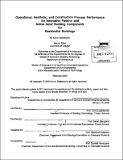Operational, aesthetic, and construction process performance for innovative passive and active solar building components for residential buildings
Author(s)
Settlemyre, Kevin (Kevin Franklin), 1971-
DownloadFull printable version (53.03Mb)
Other Contributors
Massachusetts Institute of Technology. Dept. of Civil and Environmental Engineering.
Advisor
Chris Luebkeman and Sarah Slaughter.
Terms of use
Metadata
Show full item recordAbstract
A system-based framework creates the ability to integrate operational, aesthetic, and construction process performance. The framework can be used to evaluate innovations within residential construction. By reducing the constraints for use, the framework is adaptable and flexible to specific projects and to the alternatives developed by the user. Passive and active solar design strategies are brought together in the creation of the Energy Producing Wall (EPW) components. Two component types, EPW1 & EPW2, can be adapted to create five different panel types. These units can be installed on the roof or vertical walls, and provide the innovative subject for evaluation within the framework. Four alternatives within two prototype homes, located in two climates, were analyzed to represent the existing and potential stock of housing and to provide the source of input data into the framework. An adaptable spreadsheet analysis, based on past and current analytical methods, establishes the EPW's potential benefit on the heating, cooling, electricity and total energy consumption loads within the prototype designs . Visualization models combined with physical models assess the aesthetics. The development of a Dynamic Process Model for Light Wood Framing (DPM-LWF) represents the framing construction process for the prototype designs, and provides time and cost impacts of the EPW alternatives. The. results from each analytical tool are combined to analyze the impacts of implementation, case results and sensitivities within the cases. A 'case result format' presents the results of the multiple alternatives for direct comparison, and can guide further investigations and information within the document. The EPW components demonstrated a 95% benefit for the electrical load of the "Modern Design" in Phoenix (currently), and the potential to reach over 100% benefit of the heating load in Boston for the "Sears Design."
Description
Thesis (S.M.)--Massachusetts Institute of Technology, Dept. of Architecture; and, (S.M.)--Massachusetts Institute of Technology, Dept. of Civil and Environmental Engineering, 2000. Includes bibliographical references (leaves 295-300).
Date issued
2000Department
Massachusetts Institute of Technology. Department of Architecture; Massachusetts Institute of Technology. Department of Civil and Environmental EngineeringPublisher
Massachusetts Institute of Technology
Keywords
Architecture., Civil and Environmental Engineering.